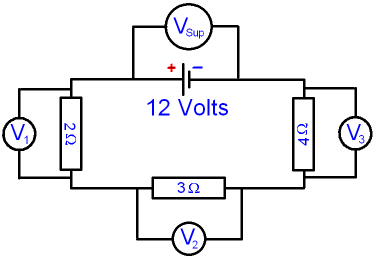
gcsescience.com 17 gcsescience.com
Calculation of Voltages and Current in a Series Circuit.
If the supply voltage (from
the cell) is 12
volts
in the circuit below,
what are the voltages across
each resistor?

From the previous page, the total resistance is 9 ohms.
In a series circuit the current is the same everywhere.
The equation
voltage = current x
resistance V = I x R
can be rearranged to give
current
= voltage
÷ resistance
I =
V
÷ R
In the circuit above,
I =
V
÷ R
= 12
÷ 9
= 1·333 amps.
Compare this current with a parallel
circuit.
Using the same
equation V
= I
x R for each resistor in turn
(and rounding up numbers) gives
V1 =
1·333 x
2
=
2·667 volts.
V2 =
1·333 x
3
= 4·000 volts.
V3 =
1·333 x
4
= 5·333 volts.
We can see that the largest
resistor at 4 ohms
has
the largest voltage (5·333 volts)
and the smallest resistor
at 2 ohms has the
smallest
voltage (2·667
volts) across
it.
In energy terms, the largest
amount of work
is done
by the charge moving through the
largest
resistance.
Finally, we
can check that
the voltage across
all of the
components adds up to the
supply voltage.
V1 + V2 + V3 = 2·667 + 4·000 + 5·333
=
12 volts.
![]() Links
Electricity
Series Circuits
Revision Questions
Links
Electricity
Series Circuits
Revision Questions
![]()
gcsescience.com Physics Quiz Index Electricity Quiz gcsescience.com
Home GCSE Chemistry GCSE Physics
Copyright © 2015 gcsescience.com. All Rights Reserved.